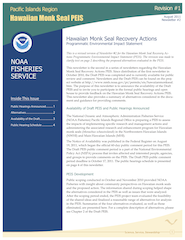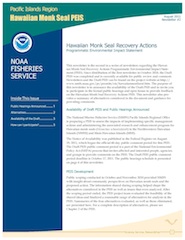Media Watch, Honolulu Civil Beat, 11 August 2011
 Hawaiian monk seals and local fishermen haven’t been getting along very well. And fishermen aren’t happy about a proposal to extend a conservation zone around the main Hawaiian islands to further protect the endangered species.
Hawaiian monk seals and local fishermen haven’t been getting along very well. And fishermen aren’t happy about a proposal to extend a conservation zone around the main Hawaiian islands to further protect the endangered species.
This was the message conveyed to representatives of the National Oceanic and Atmospheric Administration throughout two hours of heated testimony on Thursday at Ala Moana Beach Park.
More than 60 people turned out for the public hearing to discuss the proposal that would expand the critical habitat area for the seals, which have been protected under the Endangered Species Act since 1976. It is illegal to harass or kill the seals. […]
But the plight of the monk seal hasn’t swayed many fishermen, if the testimony at the public hearing is any indication.
“They’re more of a nuisance than anything else right now,” said Brandon Hu. “I fish a lot at night. One of those seals started hiding under my boat. It takes fish from my lines, then my partner’s line. We’re losing fish left and right. We moved three miles down the coast. The monk seal started following us. They are already trained to be looking for our boats for a free handout.”
While only 153 monk seals are believed to be trolling the waters around the main Hawaiian islands, fishermen complained about the economic effects the seals were having on their fishing operations and their concern about the population growing. […]
Source: Fishermen oppose extra protections for Hawaiian monk seals, Honolulu Civil Beat, 11 August 2011
 NOAA has released a revised newsletter for the Hawaiian Monk Seal Recovery Actions Programmatic Impact Statement (PEIS). In an accompanying explanation, NOAA states: “The revisions aim to provide clearer language about the proposed alternatives evaluated in the PEIS. Language was changed on page 2 of the newsletter to clarify what Alternatives 1, 2, and 3 would not include.”
NOAA has released a revised newsletter for the Hawaiian Monk Seal Recovery Actions Programmatic Impact Statement (PEIS). In an accompanying explanation, NOAA states: “The revisions aim to provide clearer language about the proposed alternatives evaluated in the PEIS. Language was changed on page 2 of the newsletter to clarify what Alternatives 1, 2, and 3 would not include.”
 NOAA. 2011. Hawaiian monk seal recovery actions. Programmatic environmental impact statement. NOAA Fisheries, Pacific Islands Region. August 2011, Newsletter # 2: 1-6. [
NOAA. 2011. Hawaiian monk seal recovery actions. Programmatic environmental impact statement. NOAA Fisheries, Pacific Islands Region. August 2011, Newsletter # 2: 1-6. [ Hawaiian monk seals and local fishermen haven’t been getting along very well. And fishermen aren’t happy about a proposal to extend a conservation zone around the main Hawaiian islands to further protect the endangered species.
Hawaiian monk seals and local fishermen haven’t been getting along very well. And fishermen aren’t happy about a proposal to extend a conservation zone around the main Hawaiian islands to further protect the endangered species.